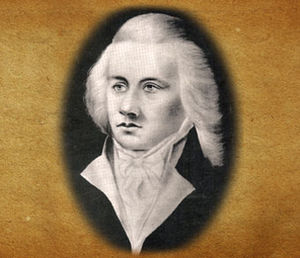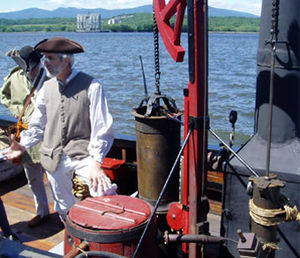Steamboats
This article was initially written by Robert Woods, ASME Fellow. This article contains material published in Mechanical Engineering Magazine Apr. 2009. Copyright 2009 American Society of Mechanical Engineers
It is easy to fall into the habit of thinking that the Founding Fathers brought about the American Revolution and then faded into some sort of oblivion. On reflection, however, we realize that all of them were human beings faced with the need to earn a livelihood even after the glory days.
Benjamin Franklin returned from his post as Ambassador to France and opened a printing shop. Thomas Jefferson took time off from his meticulous architectural drafting to become Secretary of State. George Washington managed a plantation and, in 1785, became president of a company that sought to make the Potomac River navigable.
Different as their talents may have been, all of these men came to be involved at the earliest stage of steam navigation. They were all tied together not only by supporting the movement for American independence, but also by having dealings with the two men who conceived what is now the steamboat. The work described here occurred a quarter of a century before Robert Fulton demonstrated the Clermont, the boat that led to his being regarded as the inventor.
As in the case of Newcomen, Watt, and the steam engine, the man who gets most of the credit for an invention is typically not the innovator, but the one who makes the idea pay. The real innovators of steam propulsion were John Fitch and James Rumsey. They began meaningful experiments around 1786. Fulton's successful demonstration did not come until 1807. Fitch and Rumsey arc usually dismissed with a brief mention when the evolution of the steamboat is discussed.
Both of these men were outstanding, but in very different ways. Rumsey was a mechanical genius of the intuitive school. He had an innovative approach to solving mechanical problems. Among other things, he did seminal work on the application of impulse turbines to mill wheels.
Fitch was a colorful Frontier character whose autobiography reads like a book by James Fenimore Cooper as rewritten by Leonardo daVinci. He seemed fared to suffer misfortunes, and they eventually resulted in his suicide.
The two men came into direct conflict in 1788 because the patent laws in the new United States were inadequate to give either of them the protection that they felt that their innovations deserved.
Their steamboat stories can be traced to 1784, shortly after the Revolution that effectively ended at Yorktown in 1781.
Rumsey had the advantage from the very beginning. He was a successful architect and innovator who had already conceived a fanciful and ultimately unsuccessful means of propelling a boat against river current when George Washington appointed him superintendent of the Potomac ("Patowrnack") River Project.
Meanwhile, Fitch was recovering from a career that had already involved having had his foundry destroyed by the British and going into frontier surveying, during which he successfully laid claim to large tracts of land and was captured by Indians. During his captivity, Fitch lived on more or less friendly terms with the Indians, who handed him over to the British to use in an exchange of prisoners of war. Fitch later established a metal working and clock repair shop, using tools that he made out of scrap barrel hoops with his bare hands.
Evolutions of Steam
Steamboat development was a logical evolution of Newcomen's engine, which had been reduced to practice around 1710. Fitch and Rumsey both used some variant of the Newcomen engine, although each started with a different concept. Fitch was initially interested in steam carriages, although he soon turned to a steam rowboat. At the same time, Rumsey was abandoning his idea of a water wheel propelled pole boat and turning to an ingenious application of the Newcomen engine.
Rumsey had demonstrated to Washington his working model of something that sounds at first like a perpetual motion machine. The flow of water past a catamaran that had a water wheel between its poncoons caused the boat to move against the current. He accomplished this by having the water wheel drive a reciprocating pair of axial carriages that had poles reaching to the river bottom. This worked, but it was not at all practical.
Having a good engineer's grasp of the fact that a straight line is the shortest route between two points, Rumsey turned to connecting a hydraulic pump piston directly to the piston of a Newcomen engine. He retained the traditional walking beam linkage only to pm.ver accessories like water pumps.
In this assembly, he produced an entirely respectable example of jet propulsion. The pump took in water from near the keel and then ejected it at the stern of the boatan arrangement that was functionally similar to the "putt-putt" boats that were popular with children before the birth of the Consumer Product Safety Commission. In them, water flashed to steam in a boiler that was connected to the outside by a thin cube below the water line. The momentum of the ejected water caused it to leave the boiler with a partial vacuum, this siphoned water into the boiler, and the cycle was repeated. It was aided by a flexible diaphragm. Rumsey demonstrated the jet concept successfully at Shepherdstown, W. Va., in 1787.
The pulsating jet concept was introduced to America by Benjamin Franklin. While Ambassador to France, Franklin had heard learned speculation on the possibility of propelling a boat with a jet of water. He reported on this to the American Philosophical Society in 1785 after his return, and even described a manually pumped jet boat. (The American Philosophical Society is still a respected factor in American science, as well as being a repository for historical publications and artifacts dating back to the revolution.)
Unfortunately, Franklin's report had the effect of setting back development by several years because he argued convincingly that paddle wheels would not work. This misled workers into exploring a number of dead ends.
While Rumsey was experimenting with jet boats, Fitch had gone through several evolutions aimed at getting the power from a Newcomen engine into propulsive effort. He had not been successful with a primitive propeller and had gone through a number of paddle arrangements.
The initial one, which attempted to duplicate the reciprocating action of a gang of rowers, and which must have awakened unhappy memories oflndian war canoes, was not successful, although it worked after a fashion. It involved a complex linkage of the kind that today delights instructors in Kinematics 101.
Fitch had better fortune with an array of paddles at the stern of a boat broadside to the direction of travel. By moving those fore-and-aft, a usable thrust was developed. Presumably, they were feathered on the backstroke, although the drawings do not make this clear. A boat using this arrangement was actually used in 1788 to carry passengers between Philadelphia and Burlington, N.J., while Rumsey was promoting his jet boat in demonstrations on the Potomac at Shepherdstown.
Later, Rumsey began a patent war by mendaciously claiming that his boat of 1784 was really a steamboat. The patent laws in the United States were just being developed at that time, and there was enough ambiguity to allow both men to present what they thought to be legitimate claims. Both inventors later tried to obtain patents in England.
The controversy between Rumsey and Fitch went so far as to involve Thomas Jefferson, who was an inventor in his own right. As Secretary of State, Jefferson was a member of the board that issued patents. Through all succeeding controversy, Washington continued to support Rumsey, and Benjamin Franklin was involved on and off as an expert witness.
As with the Newcomen engine, patent ]av.rs in England were no help. They were naive enough that any contrivance that used steam could be regarded as infringing another patent, even though the two hardware embodiments bore no resemblance to each other.
Since the blog had not been invented in the 18th century, it appears that persons hoping to recruit public support published pamphlets. It is not immediately clear who actually read those things, but a war between the two men broke out with Rumsey's publication of a pamphlet claiming invention of the steamboat. That was immediately followed by Fitch's published rebuttal.
Neither man was entirely above reproach. It appears, for example, that Rumsey improperly claimed precedence by pretending that his 1784 water-wheel boat was steam-powered. On the other hand, it appears that Fitch improperly claimed to have invented the water tube boiler.
Deaths of the Principals
Rumsey's death in 1792, shortly after having delivered a lecture to Britain's Society of Mechanic Arts, ended the exchange, although the controversy goes on to this day. A particu lar question is that of who invented the boiler, which so greatly increased the efficiency of the Newcomen engines.
Fitch's life went on for six years after Rumsey's. He was dogged by progressive misfortunes. He saw a number of near-successes fail for lack of funding. Many of his troubles were certainly not of his own making. In desperation, he went to France in the hopes of getting support. The unrest before the French Revolution, which would start in 1789, and an American consul at l'Orient who, while holding his papers for safekeeping, loaned them to Robert Fulton, further contributed to his downfall.
Fitch finally died in 1798, a tragic figure, by overdosing himself with opium pills after a prolonged but unsuccessful effort to drink himself to death with alcohol that he purchased by bartering away his land holdings.
The Rumseian Society that was formed in the 1780s to raise funding, was reestablished in 1906 and exists today in Shepherdstown, where a replica of Rumsey's boat has been constructed. A bridge across the Potomac is named for him. John Fitch is commemorated by a painting that hangs in the U.S. Capitol o and by the John Fitch Way, a highway that runs between the Delaware River and the state Capitol in Trenton, N.J.
The steamboat was finally raised to financial success in August 1807 by Fulton.


